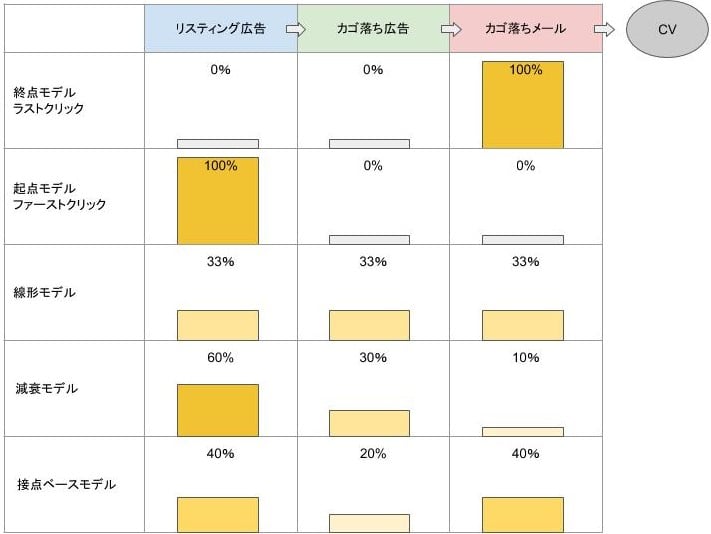Articles
- CART RECOVERY
- Articles
- Thinking about EC site conversions-5 attribution analysis
Thinking about EC site conversions-5 attribution analysis

1. What is attribution analysis?
Have you ever verified "what triggered the purchase" when a user who visited an EC site purchased a product (when converting)?
If you can think about what was effective among various measures such as advertisements, e-mail newsletters, and tools for leaving the site, it is possible to come up with appropriate "sales increase measures" for the site.
On many e-commerce sites, it is common to evaluate measures for the final search.
This is called the "last click".
However, this evaluation method alone cannot evaluate the process leading up to the purchase, such as "what triggered the knowledge of the product".
"Attribution analysis" can measure the contribution of multiple measures leading up to product purchase.
Two or five attribution models
Attribution analysis is the idea created to determine which ads are contributing to conversion, and there are several typical types (models). Using this to perform analysis to determine the policy of attracting customers and communicating with customers is called "attribution analysis".
This time, I will explain the basic knowledge in an easy-to-understand manner while introducing five attribution models.
[1] End point model (last click)
The "end point model" is the idea that only the last advertisement or email seen by the user who purchased the product contributed to the result (conversion) of the purchase. It is suitable for business models that are completed in a short cycle such as campaigns.
[2] Starting model (first click)
The "starting point model" is the opposite of the last click model, and is a model that contributes only to the advertisements and emails that the user who purchased the product first viewed.
It is suitable for advertisements and campaigns that make people aware of new brands and products.
If you don't know your brand or site, it's important to advertise with your ads. Use this model as a way to measure the effectiveness of your ads.
[3] Linear model The "linear model" is a model that evenly distributes the degree of contribution to all advertisements and emails that the user browses when purchasing a product.
If the user who purchased the product viewed four ads (campaign announcement, two banners, and e-mail newsletter), we will allocate a contribution of 25% to all of them.
Contribution is assigned to all ads, so it is an easy model to analyze.
[4] Damping model The "damping model" is a model in which all the advertisements and emails that the user contacts before purchasing the product contribute to the conversion, but the contribution is higher as the advertisement is closer to the purchase. .. The later you contact the ad, the higher the contribution will be allocated.
Like the last click model, it is suitable for models that can be completed in a short period of time, such as campaigns.
[5] Contact-based model The "contact-based model" is a model that allocates a large amount of contribution to the advertisements and emails that the user first and last contacted when purchasing a product.
The idea is to allocate 40% to each of the first and last contacts and the remaining 20% to points in the middle.
We focus on the media that made people aware of new brands and products, and the media that led to conversion decisions.
This verification method is effective when crossing many channels.
Explained with 3 or 5 attribution model diagrams
We have created a diagram that illustrates the five attribution models.
The following is an analysis assuming that the listing advertisement was converted via the CART RECOVERY basket drop advertisement and the basket drop email.

*% of the image is the number of contribution.
* The% of the attenuation model is in a row.
4, summary
The attribution model you should choose depends on your purpose.
Attribution analysis will give you an opportunity to think about your specialty and purpose, so why not take a closer look at the advertisements related to your site?
Also, for example, if you are actually considering setting with Google Ads or Google Analytics, please check the URL of the Google Help article below.
https://support.google.com/google-ads/answer/6259715?hl=ja
Also, when considering attribution analysis, I think that if you have knowledge about ad conversion and email conversion, you will be able to come up with better measures.
Please also refer to the article below.
・How to get conversions What EC sites should do to increase conversions・Think about conversions on EC sites ~Advertising~
・Thinking about EC site conversion ~Email edition~
5. Introduction of CART RECOVERY
While checking what triggered the conversion of the EC site, how about considering CART RECOVERY that approaches the user closest to the conversion as an easy measure to improve the conversion?
With CART RECOVERY, you can approach users who have lost their baskets by email and advertisement and bring them back to the site.
First, try the effect with a Get started for FREE and see how CART RECOVERY can contribute.
* The service can be used only with the recovery mail function (remarketing function).
* Advertising fee will be charged by DSP for the remarketing cooperation function.
New Articles articles

